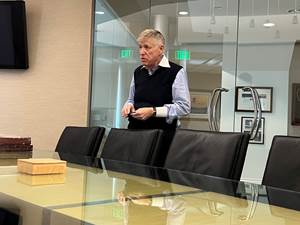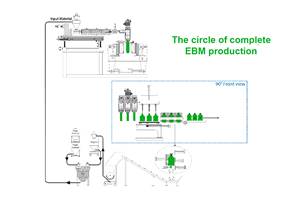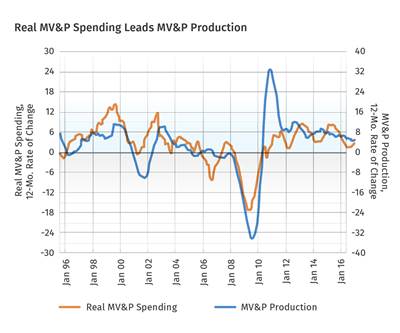Growth in Electronics Production to Remain Weak
Spending on electronics has been growing, but the pace is probably not sustainable.
While electronics production is at all-time highs, the rate of growth in production is the slowest since 2009. If you exclude the last two recessions, which were the last two times electronics production contracted, then the recent growth in electronics production was the slowest since the mid-1980s. It appears that electronics pro- duction is poised for moderately faster growth in the months ahead; but given the trend in disposable income, I’m not sure how long that will last. Let’s look at the underlying factors.
Real 10-Yr Treasury Rate. The real (inflation-adjusted) 10-yr U.S. Treasury bond interest rate was 1.07% in January, a slight decline from December 2016. But, the rate has been above 1% for the last two months after five months below 1%. The nominal rate sits at 243 basis points (2.43%), which is the second highest since September 2014. But the rate of inflation also has been rising. In January, inflation was above 2.5%. Increasing inflation is limiting the rise in the real 10-yr Treasury rate even though the nominal rate has increased (the real rate is the nominal rate minus inflation). The year-over-year change in the real rate was still negative, but less so—it increased to -78 basis points (-0.78%).
Real Disposable Income. December real disposable income was roughly $12. 8 billion (seasonally adjusted at an annual rate), an all-time high. In December, real disposable income grew 2.1% com- pared with a year ago. This was the slowest rate of growth since January 2014. The month-over-month annual rate of growth was below 3% in 10 of the last 11 months. The annual rate of growth has decelerated steadily since August 2015. In December, the annual rate of growth, 2.7%, was the slowest since October 2014. Also, this was the sixth month in a row that the annual rate of growth was below 3.1%, which is the historical average.
Real Electronics Spending. Real consumer electronics spending was $459.3 billion (seasonally adjusted at an annual rate) in December. Compared with one year ago, electronics spending in December increased 18.5%. The rate of growth has accelerated for five straight months and was growing at its fastest rate since August 2010. As a result, the annual rate of growth has accelerated for five months to virtually its fastest rate in five years.
Electronics Industrial Production. In December, electronics production grew 3.8% compared with a year ago. The last four months of 2016 saw faster growth than the period from March 2015 to September 2016. However, the rate of growth in the last four months was still below the historical average of 6.2%. The annual rate of growth accelerated for the fourth month in a row but is still tepid for the electronics industry.
Given that disposable income continued on a slower growth trend, it doesn’t seem like the accelerating growth in electronics spending is sustainable. So I expect growth in electronics production to remain weak.
ABOUT THE AUTHOR: Steven Kline Jr. is part of the fourth-generation ownership team of Cincinnati-based Gardner Business Media, which is the publisher of Plastics Technology. He is currently the company’s director of market intelligence. Contact: (513) 527-8800 email: skline2@gardnerweb.com; blog: gardnerweb.com/economics/blog
Related Content
BMW Group Vehicle to Adopt 3D Printed Center Console
A vehicle coming to market in 2027 will include a center console carrier manufactured through polymer robot-based large-format additive manufacturing (LFAM).
Read MoreMedical Tubing: Use Simulation to Troubleshoot, Optimize Processing & Dies
Extrusion simulations can be useful in anticipating issues and running “what-if” scenarios to size extruders and design dies for extrusion projects. It should be used at early stages of any project to avoid trial and error and remaking tooling.
Read MoreUS Merchants Makes its Mark in Injection Molding
In less than a decade in injection molding, US Merchants has acquired hundreds of machines spread across facilities in California, Texas, Virginia and Arizona, with even more growth coming.
Read MoreGet Color Changes Right In Extrusion Blow Molding
Follow these best practices to minimize loss of time, material and labor during color changes in molding containers from bottles to jerrycans. The authors explore what this means for each step of the process, from raw-material infeed to handling and reprocessing tails and trim.
Read MoreRead Next
New Vehicle Sales at All-Time High
Yet production is growing at a slower pace, a trend that is likely to continue.
Read MoreBeyond Prototypes: 8 Ways the Plastics Industry Is Using 3D Printing
Plastics processors are finding applications for 3D printing around the plant and across the supply chain. Here are 8 examples to look for at NPE2024.
Read MoreMaking the Circular Economy a Reality
Driven by brand owner demands and new worldwide legislation, the entire supply chain is working toward the shift to circularity, with some evidence the circular economy has already begun.
Read More.JPG;width=70;height=70;mode=crop)










